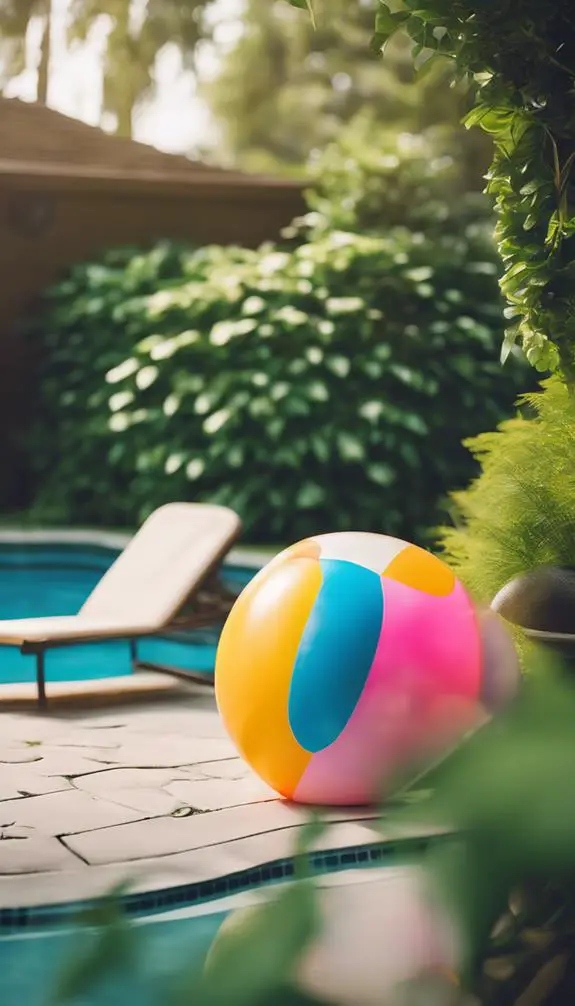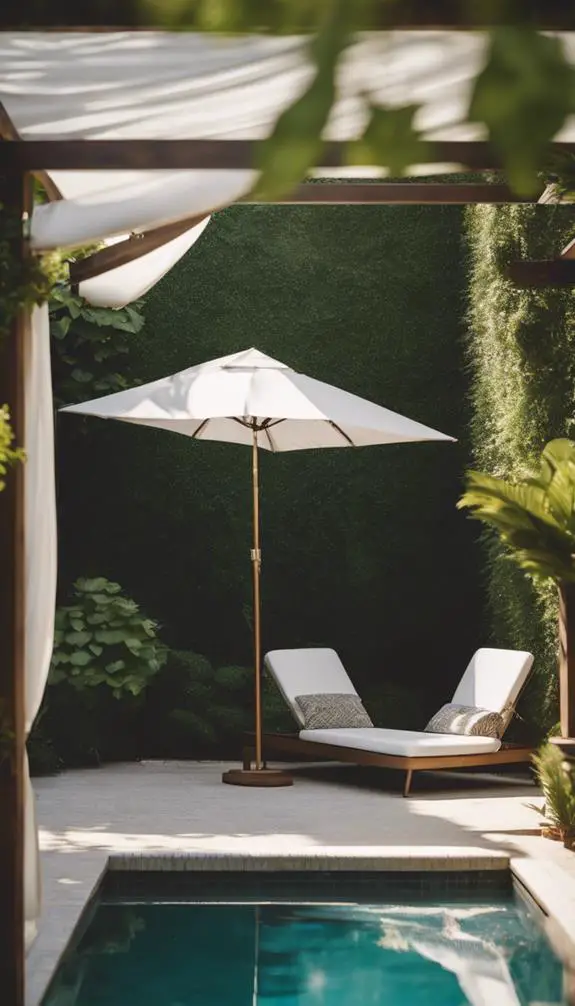As you step into your small garden, you're faced with the challenge of creating a beautiful and functional space within a limited footprint. You're not alone – many of us are working with compact outdoor areas that can feel cramped and claustrophobic. But what if you could transform this tiny space into a serene oasis that's both visually stunning and highly functional? By employing clever design strategies, you can create the illusion of more space, maximize every square foot, and even make the most of those awkward corners. But where do you start?
Summary
- Maximizing space with vertical planters and wall gardens creates a new dimension for plants to thrive in small gardens.
- Selecting compact plant varieties that fit comfortably in containers ensures they won't outgrow their space.
- Multifunctional features like seating areas that double as pathways optimize every square foot in small gardens.
- Utilizing corner spaces with triangular planters or corner shelves adds greenery and visual interest to neglected areas.
- A cohesive color scheme and ambiance created with thoughtful design elements and lighting can transform a small garden into a peaceful oasis.
Maximizing Space With Verticals
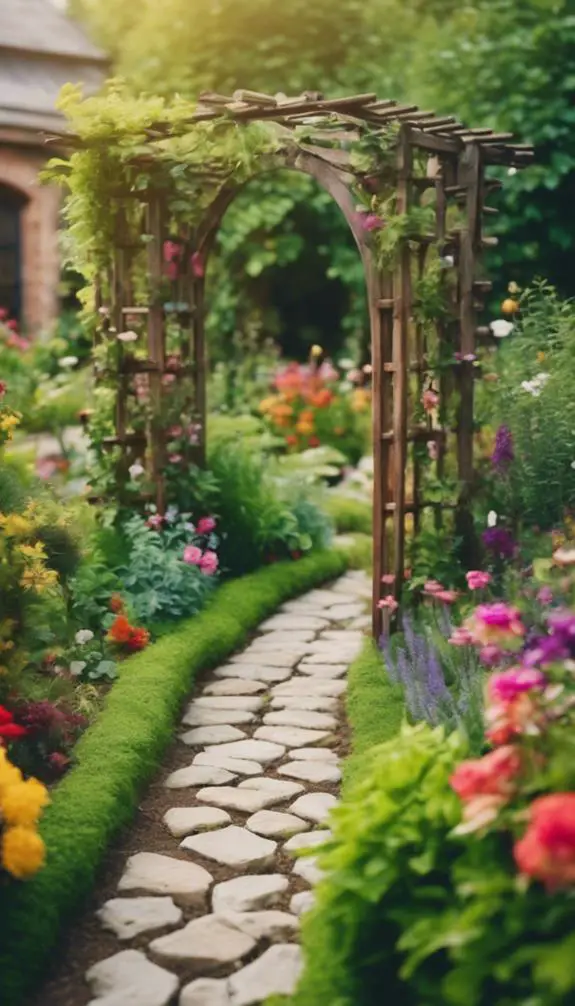
In small gardens, where every inch counts, looking up towards the sky can be a game-changer.
You'll find that vertical planters and wall gardens are innovative solutions to maximize space. By installing a trellis or a wall-mounted planter, you're creating a new dimension for your plants to thrive.
This approach not only saves floor space but also adds visual interest to your garden. Imagine vines or flowering plants cascading down a wall or a fence, creating a stunning display.
With vertical planters, you can grow a variety of plants, from herbs to succulents, in a compact and organized manner. By going vertical, you're tapping new possibilities for your small garden, making it feel more spacious and dynamic.
Selecting Compact Plant Varieties
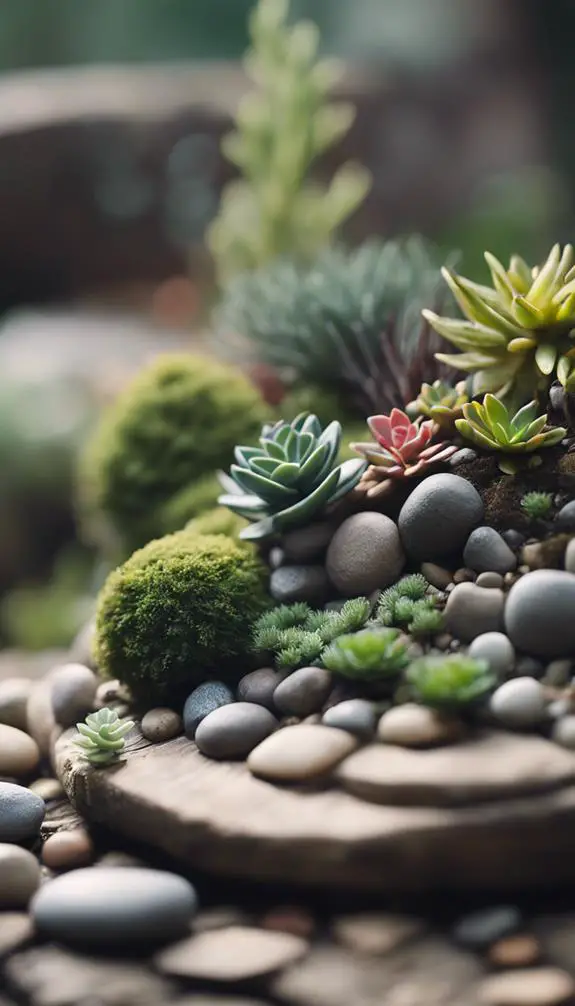
You've carefully planned your small garden, incorporating vertical planters and maximizing space.
Now, it's time to select plant varieties that will thrive in your compact garden. Look for plant profiles that feature compact growth, guaranteeing they won't outgrow their containers.
Dwarf or compact varieties of popular plants like tomatoes, peppers, and herbs are ideal for small gardens. These varieties have been bred to maintain a smaller stature while still producing abundant yields.
When selecting plants, consider factors like mature size, growth rate, and pruning requirements to verify they'll fit comfortably in your garden.
Small-Scale Hardscaping Ideas

With your compact plant varieties in place, turn your attention to the hardscaping elements that will enhance your small garden's functionality and visual appeal.
You'll want to create a cohesive look by selecting paver patterns that complement your garden's style. Consider a mix of large and small pavers to add visual interest, or opt for a single pattern to create a sense of unity.
Don't forget about stone edging, which can help define different areas of your garden while adding a touch of elegance. Choose a stone that complements your pavers and plant varieties, and consider incorporating curves to soften the overall look.
Creating Focal Points With Decor
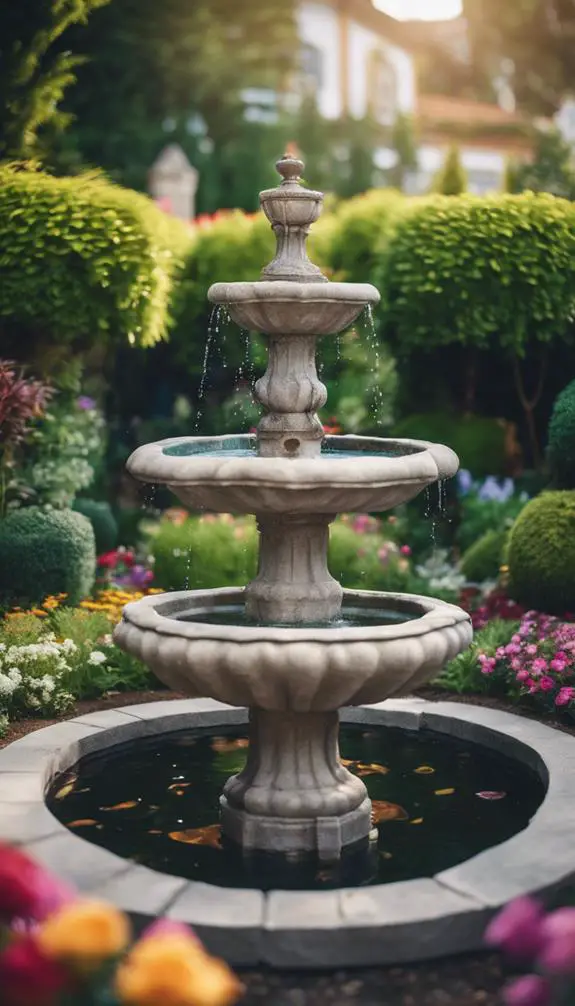
You'll create visual anchors in your small garden by incorporating decorative accents that matter, strategically placing garden statues to draw the eye.
Designing visual interest zones that guide the viewer's attention, these focal points will energize your outdoor space, making it feel more dynamic and inviting.
Decorative Accents Matter
Focal points, strategically placed throughout your small garden, draw the eye and create visual interest.
To create these focal points, incorporate decorative accents that guide the viewer's attention. Garden paths, for instance, can be designed to lead the eye to a particular area of the garden.
Accent lighting can also be used to highlight specific features, such as a water feature or a statement plant. By combining these elements, you can create a visually appealing and dynamic space.
Consider using contrasting materials, textures, and colors to add depth and dimension to your garden. Remember, the key is to create a balance between harmony and contrast to keep the viewer engaged.
Garden Statue Placement
How do you intend to make a statement in your small garden with a single, well-placed decorative element?
A strategically positioned garden statue can create a focal point, drawing the eye to a specific area and tying together your garden theme.
When placing a statue, consider the visual flow of your garden. Position it at a bend or intersection of paths to create a sense of pause, or use it to anchor a seating area.
Verify the statue's scale is proportional to the surrounding plants and hardscapes.
A Statue Focal point can elevate your garden's visual appeal, so choose a piece that resonates with your garden's style and theme. By doing so, you'll create an enthralling visual experience that invites exploration.
Visual Interest Zones
Three visual interest zones can be strategically created in your small garden to guide the viewer's eye through the space, each featuring a unique decorative element that captures attention.
These zones serve as visual anchors, drawing the eye to specific areas of the garden. By creating focal pathways, you can lead the viewer's gaze through the space, creating a sense of flow and visual harmony.
Consider placing a statement piece, like a sculpture or water feature, in each zone to create a clear focal point. This will help break up the space and create a sense of depth, making your small garden feel larger than it is.
Incorporating Multifunctional Features
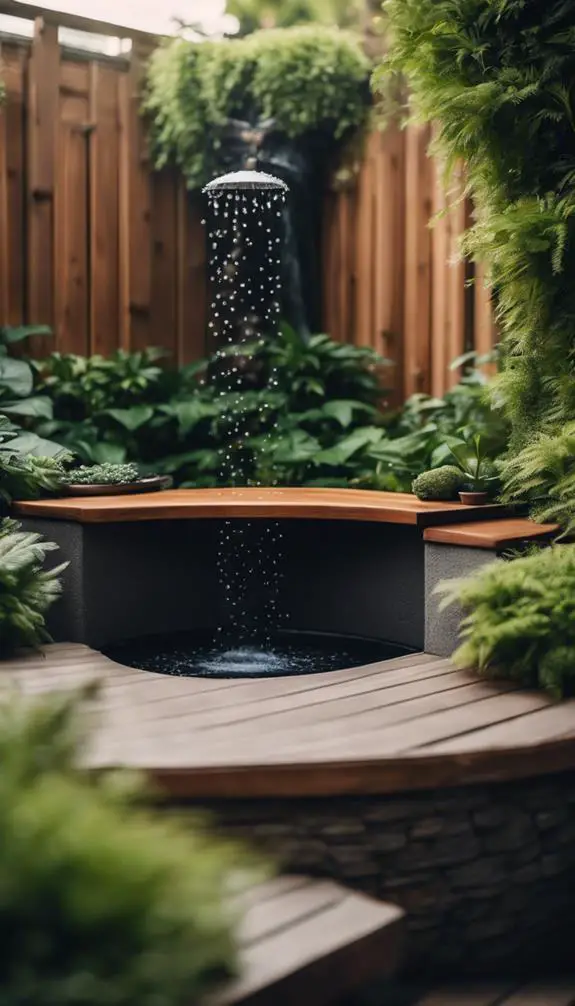
You'll maximize your small garden's potential by incorporating multifunctional features that serve more than one purpose.
Consider designing dual-purpose spaces, like a seating area that doubles as a pathway, to optimize every square foot.
Dual Purpose Spaces
By incorporating dual-purpose spaces into your small garden design, you can effectively maximize the functionality of your outdoor area without sacrificing aesthetics.
This flexibility planning approach enables you to accommodate multiple activities in a single space, revolutionizing your outdoor living experience. For instance, a seating area can double as a storage space by incorporating built-in benches with hidden compartments.
Alternatively, a vertical garden can serve as a living wall, providing both a natural screen and a habitat for wildlife. By prioritizing space efficiency, you can create a multifaceted outdoor space that adapts to your needs, making the most of your small garden's potential.
Functional Decor Elements
Incorporating functional decor elements into your small garden design enables you to strike a balance between form and function.
By choosing multifunctional features, you'll maximize your space without sacrificing style. Garden ornaments, such as planters with built-in benches or tables, serve as both decorative accents and functional seating areas.
Decorative screens can also be used to create separate zones within your garden while adding visual interest. Additionally, consider incorporating features like solar-powered lights, which provide both ambiance and illumination.
Optimizing Corner Spaces

Three out of four corners in a small garden are often overlooked, relegating these areas to mere afterthoughts.
You can, however, transform these neglected spaces into functional areas that enhance your garden's overall appeal.
Consider installing corner seating, like a built-in bench or a circular seat, to create a cozy nook for relaxation.
Alternatively, use corner planters to add greenery and visual interest.
These planters can be triangular, circular, or even tiered, allowing you to showcase multiple plants in a small footprint.
Choosing the Right Colors

As you've maximized your corner spaces, now it's time to think about the visual flow of your garden.
Choosing the right colors is vital in creating a cohesive look that reflects your personal style. Consider your garden's natural surroundings, including the colors of nearby buildings, hardscapes, and foliage.
Develop a color scheme that complements these elements, ensuring a smooth shift between your garden and its surroundings. Select a dominant color and one or two accent colors to create visual interest.
Don't be afraid to experiment with bold, contrasting hues to add depth and dimension. Remember, your color scheme should reflect your personal style and tie together the various elements of your small garden design.
Balcony Garden Design Tips
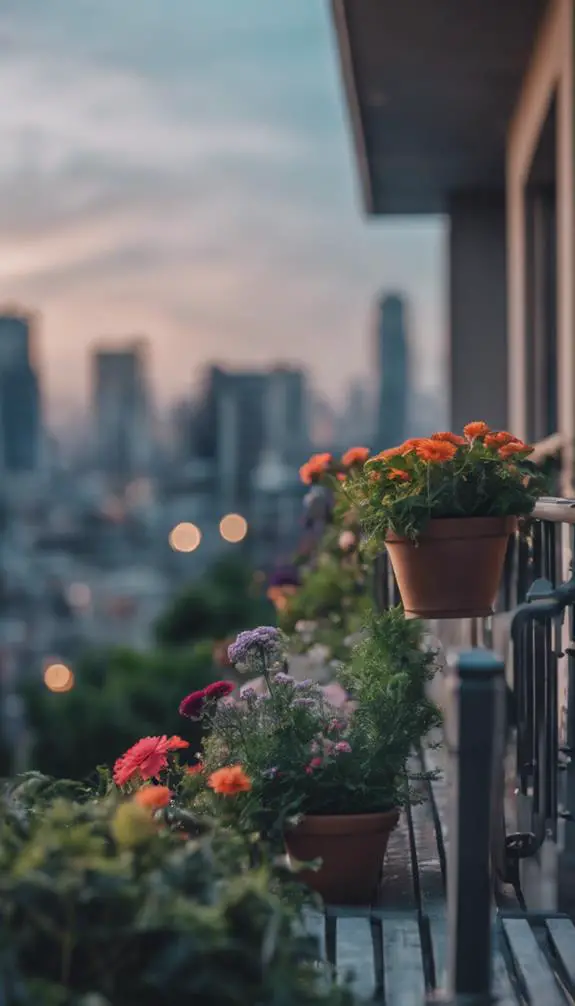
You're working with a compact balcony space, so crucially, you must maximize every inch.
By selecting the right containers and plants, you can create a thriving garden that maximizes visual appeal while minimizing spatial constraints.
As you design your balcony garden, prioritize space-saving strategies and choose containers that complement your plant selection to create a harmonious, efficient oasis.
Balcony Space Optimization
Optimizing every inch of your balcony space is crucial to creating a thriving garden oasis amidst the urban jungle.
Assess your balcony proportions to determine the most efficient layout. Consider the rail utilization by attaching planters, trellises, or a vertical garden to maximize space. This will also add depth and visual interest to your balcony.
Make the most of your balcony's corners by using triangular planters or corner shelves. By strategically placing your plants and decor, you can create a functional and aesthetically pleasing space.
With careful planning, your small balcony can become a tranquil retreat in the midst of the bustling city.
Container Plant Selection
Five to seven containers of varying sizes will likely comprise your balcony garden, so selecting the right plants for each is crucial.
You'll want to choose plants that thrive in containers, considering factors like light, temperature, and moisture requirements.
Start with a high-quality potting mix that prioritizes soil health, as this will support your plants' growth.
Consider a mix with organic matter, like compost or peat moss, to retain moisture and nutrients.
For each container, select plants with complementary growth habits and textures to create visual interest.
Don't overcrowd – leave enough space for air circulation and growth.
Patio Layout Strategies
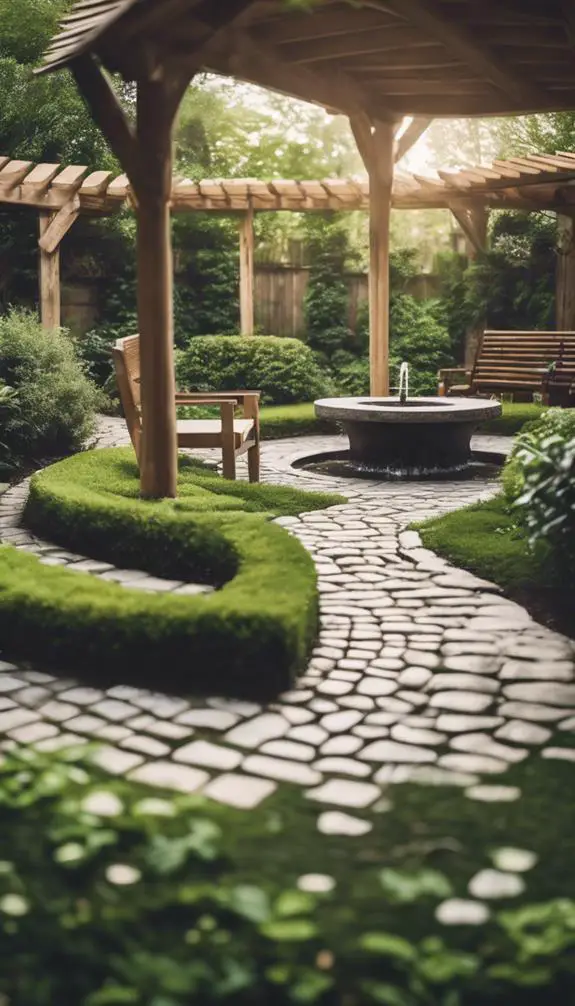
When designing a small garden, the patio layout is essential in creating a functional and aesthetically pleasing outdoor space.
You'll want to balance form and function by selecting a patio shape that complements your garden's unique constraints. Consider a circular or oval patio shape to create a sense of flow and visual interest. Alternatively, a rectangular patio can provide a clean, modern aesthetic.
Once you've determined the patio shape, focus on creating distinct seating areas. Define these spaces using different materials, such as a combination of stone and wood, or incorporate built-in benches and planters.
This strategic layout will enable you to maximize your space, creating a functional and inviting outdoor retreat.
Courtyard Garden Inspiration

Among the lush greenery and serene ambiance, a courtyard garden beckons you to escape into its tranquility.
As you step into this intimate space, you're enveloped in a sense of calm, surrounded by carefully selected plants and thoughtful design elements.
A courtyard oasis can be created even in the smallest of spaces, providing a serene retreat from the hustle and bustle of daily life.
Consider incorporating a statement water feature, like a small fountain or birdbath, to add visual interest and soothing sounds.
Strategically placed seating areas, such as a built-in bench or a hammock, invite relaxation and contemplation.
Space-Saving Storage Solutions
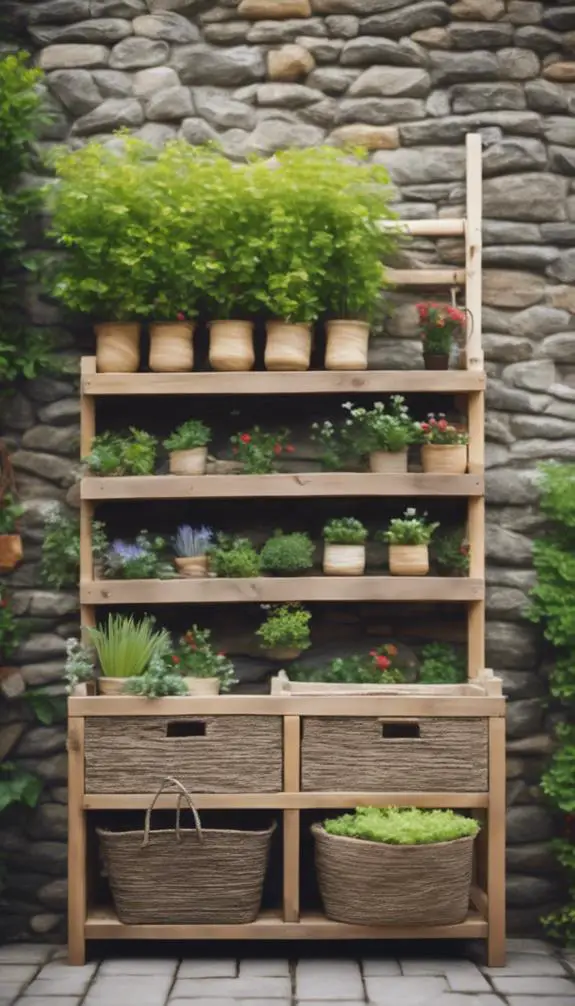
In even the smallest of courtyards, every square foot counts, making clever storage solutions essential to maintaining a sense of openness.
You'll want to maximize vertical space by incorporating hidden shelves, perfect for stashing away gardening tools, seeds, and other essentials. Consider installing cabinet organizers with adjustable compartments to keep items like potting soil, fertilizers, and pruning shears neatly organized.
Utilizing Ambient Lighting
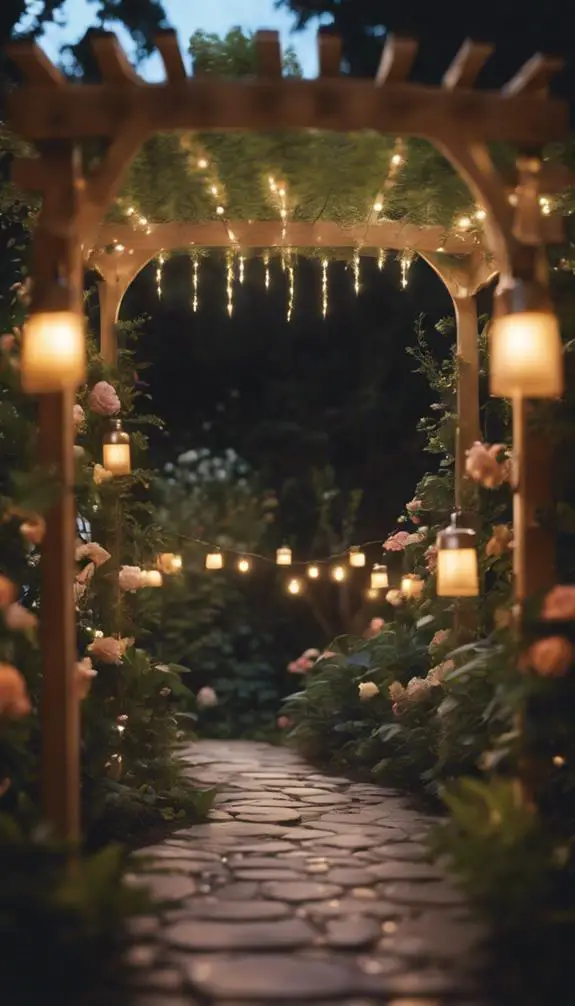
Softly illuminating pathways and highlighting garden features, ambient lighting can magically transform your small garden into an enchanting retreat, inviting you to linger under the stars.
To achieve this, consider using pathway lights with a soft glow, strategically placed to guide you through your garden's winding paths. Warm ambiance is created by installing string lights or lanterns with a warm LED tone, casting a cozy glow on seating areas or water features.
By layering different light sources, you can create visual interest and depth in your small garden. Don't forget to conceal wiring and fixtures to maintain a seamless, natural look.
With ambient lighting, your small garden becomes an inviting oasis, perfect for relaxation and entertainment.
Adding Texture With Accessories
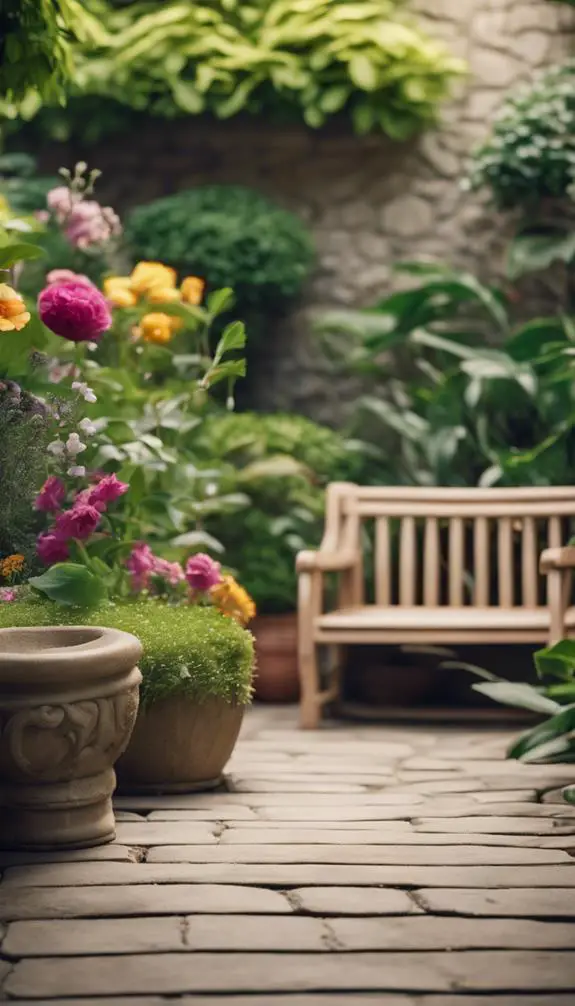
As you've set the tone with ambient lighting, now it's time to add depth and visual interest to your small garden by incorporating a variety of textures through accessories.
Introduce rustic accents like reclaimed wood planters, stone pedestals, or woven rattan furniture to create a visually appealing contrast.
Natural fabrics like linen, jute, or sisal can add warmth and coziness to your outdoor space.
Use them for cushions, throws, or even a statement piece like a fabric-wrapped pergola.
Mix and match different textures to create a dynamic visual experience.
For example, pair smooth ceramic planters with rough-hewn wooden benches or combine metallic accents with natural fibers.
FAQs
How Do I Prevent My Small Garden From Feeling Cluttered and Overwhelming?
To avoid visual overwhelm, you'll want to scale down ornaments and plants, creating a clear visual flow by grouping similar elements, using negative space, and strategically placing focal points to guide the eye through your outdoor oasis.
What Is the Best Way to Incorporate a Water Feature in a Small Space?
To incorporate a water feature effectively, you'll create a focal point by positioning it thoughtfully, then balance it with surrounding elements to avoid visual overload, ensuring the soothing sound and sight of water elevate your space without overwhelming it.
Can I Grow Vegetables in a Small Garden, and if So, How?
You can cultivate a diverse selection of veggie varieties in a compact space by strategic garden layout planning, utilizing vertical trellises, and implementing space-saving techniques like container gardening and intercropping to maximize yield.
How Often Should I Prune and Maintain My Small Garden to Keep It Looking Its Best?
You'll want to establish pruning schedules to maintain your garden's vibrancy, incorporating seasonal refreshes to revitalize your space; aim for monthly trimming, seasonal pruning, and quarterly overhauls to keep your garden looking its absolute best.
Are There Any Specific Safety Considerations I Should Keep in Mind When Designing a Small Garden?
When designing, you'll want to identify potential garden hazards, ensuring you don't create tripping obstacles or slippery surfaces. Also, be mindful of electrocution risks from exposed wires or faulty outdoor lighting, keeping them safely installed and inspected regularly.
Conclusion
You've optimized every square foot, crafting a small garden that's both functional and visually stunning. By incorporating vertical planters, compact plant varieties, and multifunctional features, you've created a dynamic space that belies its size. Hardscaping elements, decorative accents, and ambient lighting enhance the ambiance. With clever storage solutions and textural accessories, your courtyard oasis is now a serene retreat, perfect for relaxation and entertainment.


